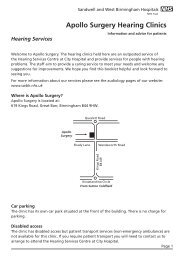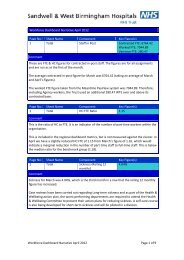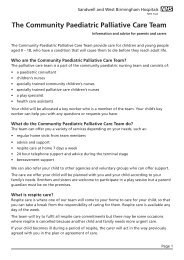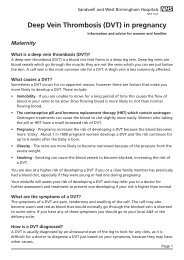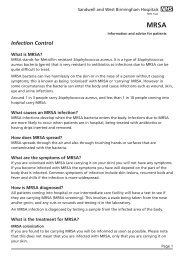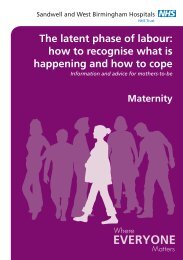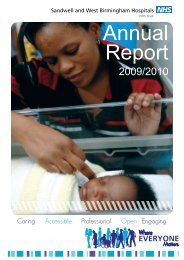Trust Board Febuary 2010 - Sandwell & West Birmingham Hospitals
Trust Board Febuary 2010 - Sandwell & West Birmingham Hospitals
Trust Board Febuary 2010 - Sandwell & West Birmingham Hospitals
You also want an ePaper? Increase the reach of your titles
YUMPU automatically turns print PDFs into web optimized ePapers that Google loves.
SWBTB (2/10) 045 (a)<br />
Table 3: Short Listed Options<br />
Option Description<br />
1 Transfer all births and consultant activity to City Hospital and retain low risk Midwifery led<br />
antenatal services at <strong>Sandwell</strong> and City <strong>Hospitals</strong> including routine screening (scans).<br />
There would be no births at <strong>Sandwell</strong> Hospital and all Consultant antenatal clinics would<br />
transfer to City Hospital concentrating all high risk care to one site. All Neonatal care would<br />
be provided at City Hospital.<br />
2 All births and in-patient maternity care would be located at City Hospital. There would also<br />
be a full range of antenatal services at City Hospital. A small number of Consultant<br />
antenatal clinics would remain at <strong>Sandwell</strong> Hospital along with a full range of Midwifery<br />
antenatal services including routine screening. There would be no births or inpatient<br />
maternity care at <strong>Sandwell</strong> Hospital. High risk in-patient care will be provided at City<br />
Hospital. All Neonatal care would be provided at City Hospital.<br />
3 All consultant led care and, all in-patient services and, temporarily all births would transfer<br />
to City Hospital. A Stand Alone Midwifery Led Birth Centre would be developed within<br />
<strong>Sandwell</strong> and, once operational, some midwifery led low risk births would relocate to the<br />
new centre in <strong>Sandwell</strong>. Low risk midwifery led antenatal care and routine screening will be<br />
available in <strong>Sandwell</strong> and at City Hospital. Consultant led antenatal care would be relocated<br />
to City Hospital. All Neonatal care would be provided at City Hospital.<br />
Do<br />
Minimum<br />
Retain all consultant led and maternity services at <strong>Sandwell</strong> Hospital and improve<br />
standards. There would be no change to the current service model with the requirement to<br />
improve the facilities to achieve the recommended standards, and also the need to improve<br />
clinical leadership, operational management and workforce capacity.<br />
4.2 Stand Alone Birth Centre<br />
A midwifery led unit or birth centre is a place that offers care to women with a predefined uncomplicated<br />
pregnancy and where midwives are the lead professional for ante-natal, intra-partum and post natal<br />
care. A stand alone birth centre is a midwifery led birth centre set up in a location away from and on a<br />
different site to a Consultant led unit.<br />
Medical services including obstetric, neonatal and anaesthetic care are available in a Consultant led<br />
unit.<br />
A review of available literature and research around midwifery led birth centres suggests that there are<br />
many benefits of giving birth in a midwifery led birth centre for women who are healthy and have a<br />
straight forward (low-risk) pregnancy. These are similar to the benefits of home birth. National policy is<br />
to increase women’s choice for place of birth and access to midwife-led care and in England the policy is<br />
that from 2009 access to a birth centre will be ‘guaranteed’. The <strong>Trust</strong> will be in a position to provide<br />
such access from April <strong>2010</strong> through the co-located Birth Centre at City Hospital. The main additional<br />
benefit of a stand alone birth centre within <strong>Sandwell</strong> would be more local access for <strong>Sandwell</strong> women.<br />
Other identified benefits to delivering in a stand alone birth centre include:<br />
• High levels of normal births<br />
• Low levels of caesarean sections<br />
• Higher levels of intact perineum<br />
• Lower episiotomy rates<br />
• More babies remaining with their mothers<br />
• Lower transfer rates for women<br />
12




